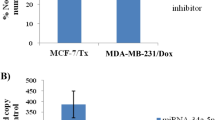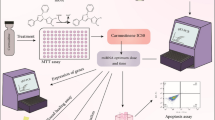Abstract
Background and Aim
Poorly differentiated thyroid carcinoma (PDTC) is an endocrine malignancy that is challenging to treat due to its limited radioiodine uptake. microRNAs (miRNAs or miRs) have been shown to be useful in treating many types of tumors, including PDTC. This study aims to evaluate the potential effect of miR-875-5p on the radioiodine uptake of PDTC and to clarify the underlying mechanisms.
Methods
Expression of miR-875-5p and sodium–iodide symporter (NIS) in tissues and cell lines was determined using RT-qPCR. The binding relationship between miR-875-5p and NIS was predicted through in silico analysis and verified by dual-luciferase reporter gene assay. A series of miR-875-5p mimic, miR-875-5p inhibitor, shRNA against NIS, and overexpressed NIS plasmids were introduced into PDTC cells. We then evaluated the cell viability, colony formation, apoptosis, and radioiodine uptake of each PDTC sample via CCK-8 assay, clonogenic assay, flow cytometry, and γ counter, respectively.
Results
miR-875-5p was found to be highly expressed, but NIS was poorly expressed in DTC tissues and PDTC cell lines. NIS was verified to be a target gene of miR-875-5p. Upregulation of miR-875-5p was found to induce PDTC cell proliferation, and reduce apoptosis and radioiodine uptake in vitro through down-regulation of NIS. In an in vivo orthotopic model, the enhancement of miR-875-5p led to the reduction of NIS expression and radioiodine uptake in the thyroid tumors.
Conclusions
Altogether, the findings of the current study suggest that down-regulated miR-875-5p expression could promote its target gene NIS to increase radioiodine uptake in PDTC, constituting a preventive strategy against PDTC.






Similar content being viewed by others
Change history
14 July 2022
This article has been retracted. Please see the Retraction Notice for more detail: https://doi.org/10.1007/s40618-022-01852-0
References
Setia N, Barletta JA (2014) Poorly differentiated thyroid carcinoma. Surg Pathol Clin 7(4):475–489
Xu B, Ghossein R (2016) Genomic landscape of poorly differentiated and anaplastic thyroid carcinoma. Endocr Pathol 27(3):205–212
Volante M, Rapa I, Gandhi M et al (2009) RAS mutations are the predominant molecular alteration in poorly differentiated thyroid carcinomas and bear prognostic impact. J Clin Endocrinol Metab 94(12):4735–4741
Ibrahimpasic T, Ghossein R, Carlson DL et al (2014) Outcomes in patients with poorly differentiated thyroid carcinoma. J Clin Endocrinol Metab 99(4):1245–1252
Shahbazigahrouei DNS, Shokrani P et al (2009) Determination of absorbed dose of organs (thyroid, sternum, cervical vertebra) in thyroid cancer patients following radioiodine therapy. Iran J Nucl Med 17(1):27–33
Sapienza MT, Endo IS, Campos Neto GC et al (2005) Radioiodine therapy for differentiated thyroid carcinoma: methods used to increase the radiation absorbed dose. Arq Bras Endocrinol Metab 49(3):341–349
Schwertheim S, Sheu SY, Worm K et al (2009) Analysis of deregulated miRNAs is helpful to distinguish poorly differentiated thyroid carcinoma from papillary thyroid carcinoma. Horm Metab Res 41(6):475–481
Macfarlane LA, Murphy PR (2010) MicroRNA: biogenesis, function and role in cancer. Curr Genom 11(7):537–561
Ryan BM, Robles AI, Harris CC (2010) Genetic variation in microRNA networks: the implications for cancer research. Nat Rev Cancer 10(6):389–402
Deng X, Wu B, Xiao K et al (2015) MiR-146b-5p promotes metastasis and induces epithelial-mesenchymal transition in thyroid cancer by targeting ZNRF3. Cell Physiol Biochem 35(1):71–82
Li D, Jian W, Wei C et al (2014) Down-regulation of miR-181b promotes apoptosis by targeting CYLD in thyroid papillary cancer. Int J Clin Exp Pathol 7(11):7672–7680
Wang J, Lu Y, Ding H et al (2018) The miR-875-5p inhibits SATB2 to promote the invasion of lung cancer cells. Gene 644:13–19
Patel A, Jhiang S, Dogra S et al (2002) Differentiated thyroid carcinoma that express sodium-iodide symporter have a lower risk of recurrence for children and adolescents. Pediatr Res 52(5):737–744
Spitzweg C, Bible KC, Hofbauer LC, Morris JC (2014) Advanced radioiodine-refractory differentiated thyroid cancer: the sodium iodide symporter and other emerging therapeutic targets. Lancet Diabetes Endocrinol 2(10):830–842
Volante M, Collini P, Nikiforov YE et al (2007) Poorly differentiated thyroid carcinoma: the Turin proposal for the use of uniform diagnostic criteria and an algorithmic diagnostic approach. Am J Surg Pathol 31(8):1256–1264
Hannallah J, Rose J, Guerrero MA (2013) Comprehensive literature review: recent advances in diagnosing and managing patients with poorly differentiated thyroid carcinoma. Int J Endocrinol 2013:317487
Simoes-Pereira J, Moura MM, Marques IJ et al (2019) The role of EIF1AX in thyroid cancer tumourigenesis and progression. J Endocrinol Invest 42(3):313–318
Dettmer MS, Perren A, Moch H et al (2014) MicroRNA profile of poorly differentiated thyroid carcinomas: new diagnostic and prognostic insights. J Mol Endocrinol 52(2):181–189
Li X, Abdel-Mageed AB, Mondal D, Kandil E (2013) MicroRNA expression profiles in differentiated thyroid cancer, a review. Int J Clin Exp Med 6(1):74–80
Khan S (2014) Molecular mechanisms and tumour heterogeneity in breast cancer. http://hdl.handle.net/10379/4633
Li L, Lv B, Chen B et al (2015) Inhibition of miR-146b expression increases radioiodine-sensitivity in poorly differential thyroid carcinoma via positively regulating NIS expression. Biochem Biophys Res Commun 462(4):314–321
D’Agostino M, Sponziello M, Puppin C et al (2014) Different expression of TSH receptor and NIS genes in thyroid cancer: role of epigenetics. J Mol Endocrinol 52(2):121–131
Galrao AL, Sodre AK, Camargo RY et al (2013) Methylation levels of sodium-iodide symporter (NIS) promoter in benign and malignant thyroid tumors with reduced NIS expression. Endocrine 43(1):225–229
Li CC, Ho TY, Kao CH et al (2010) Conserved charged amino acid residues in the extracellular region of sodium/iodide symporter are critical for iodide transport activity. J Biomed Sci 17:89
Tang M, Hou YL, Kang QQ et al (2014) All-trans-retinoic acid promotes iodine uptake via up- regulating the sodium iodide symporter in medullary thyroid cancer stem cells. Asian Pac J Cancer Prev 15(4):1859–1862
Kogai T, Brent GA (2012) The sodium iodide symporter (NIS): regulation and approaches to targeting for cancer therapeutics. Pharmacol Ther 135(3):355–370
Norden MM, Larsson F, Tedelind S et al (2007) Down-regulation of the sodium/iodide symporter explains 131I-induced thyroid stunning. Cancer Res 67(15):7512–7517
Perisinakis K, Tzedakis A, Spanakis K et al (2018) The effect of iodine uptake on radiation dose absorbed by patient tissues in contrast enhanced CT imaging: implications for CT dosimetry. Eur Radiol 28(1):151–158
Riesco-Eizaguirre G, Wert-Lamas L, Perales-Paton J et al (2015) The miR-146b-3p/PAX8/NIS regulatory circuit modulates the differentiation phenotype and function of thyroid cells during carcinogenesis. Cancer Res 75(19):4119–4130
Lakshmanan A, Wojcicka A, Kotlarek M et al (2015) microRNA-339-5p modulates Na+/I− symporter-mediated radioiodide uptake. Endocr Relat Cancer 22(1):11–21
Shen CT, Qiu ZL, Song HJ et al (2016) miRNA-106a directly targeting RARB associates with the expression of Na(+)/I(−) symporter in thyroid cancer by regulating MAPK signaling pathway. J Exp Clin Cancer Res 35(1):101
Acknowledgements
We would like to acknowledge the reviewers for their helpful comments on this paper.
Funding
This work was supported by the National Natural Science Foundation of China (No. 81070637, No. 81579742).
Author information
Authors and Affiliations
Corresponding authors
Ethics declarations
Conflict of interest
The authors declare that they have no conflict of interest.
Ethical approval
The study was conducted in accordance with the Declaration of Helsinki. The experiments that involved human subjects were approved by the Ethics Committee of the Affiliated Yantai Yuhuangding Hospital of Qingdao University. Experimental procedures performed on animals used in medical research were conducted under the approval of the Animal Ethics Committee of the Affiliated Yantai Yuhuangding Hospital of Qingdao University.
Informed consent
Participating patients have signed informed consents prior to the study.
Additional information
Publisher's Note
Springer Nature remains neutral with regard to jurisdictional claims in published maps and institutional affiliations.
This article has been retracted. Please see the retraction notice for more detail: https://doi.org/10.1007/s40618-022-01852-0"
About this article
Cite this article
Tang, Y., Meng, X., Yu, X. et al. RETRACTED ARTICLE: Inhibition of microRNA-875-5p promotes radioiodine uptake in poorly differentiated thyroid carcinoma cells by upregulating sodium–iodide symporter. J Endocrinol Invest 43, 439–450 (2020). https://doi.org/10.1007/s40618-019-01125-3
Received:
Accepted:
Published:
Issue Date:
DOI: https://doi.org/10.1007/s40618-019-01125-3




